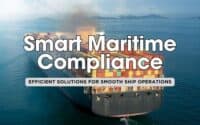Section 301 Fees: A Billion-Dollar Storm on the Horizon

What happens when nearly 40% of the vessels calling at U.S. ports suddenly face millions—if not tens of millions—in new fees? The shipping industry may be about to find out.
The U.S. government’s proposed Section 301 service fees could shake the global shipping industry to its core. With fees of up to $1 million per vessel per port call—or even more for larger ships—these tariffs primarily target Chinese-built vessels and Chinese-operated shipping lines. Given that nearly 40% of vessels calling at U.S. ports are Chinese-built, the financial impact could be staggering. As carriers grapple with these potential costs, the burden is expected to cascade down to U.S. importers, exporters, and ultimately consumers through higher freight rates and supply chain adjustments.
To hammer these figures home, we’ve put together an interactive calculator that allows you to input fleet details and port calls to estimate the significant financial burden of Section 301 fees.
ShipUniverse: Section 301 Fee Calculator
| Number of Ships in Fleet: | |
| Average Vessel Net Tonnage (NT): | |
| Annual U.S. Port Calls (Per Ship): | |
| Percentage of Chinese-Built Vessels: | |
| Carrier Type: | |
| Per Port Call Fee: - | Annual Fee (Per Ship): - | Total Fleet Annual Fee: - | |

** We welcome your feedback, suggestions, corrections, and ideas for enhancements. Please email editor @ shipuniverse.com **
1️⃣ Understanding the Proposed Section 301 Fees
The proposed Section 301 service fees are designed to impose financial penalties on Chinese-built vessels and Chinese maritime transport operators calling at U.S. ports. These measures, while still under consideration, could have a significant financial impact on global shipping if enforced.
Much of the data presented in this analysis has been provided by VesselBot, a pioneering technology company that brings transparency to value chain emissions through its Supply Chain Sustainability Platform. VesselBot’s research quantifies the potential exposure of major carriers to these fees, showing that over 20% of TEU imported into the U.S. in 2024 came from Chinese-built vessels.
What Do These Fees Cover?
The Section 301 fees are structured into three categories:
- Fees on Chinese maritime operators
- Fees on fleets using Chinese-built vessels
- Fees on companies that have ordered new ships from Chinese shipyards
Additionally, the policy offers a fee remission for U.S.-built vessels, though the availability of such vessels remains limited.
Below is a detailed breakdown of the proposed fee structure:
| ShipUniverse: Section 301 Proposed Service Fees | ||
| Category | Fee Criteria | Projected Cost per Port Call |
| Chinese Maritime Transport Operators | Applies to any vessel entering a U.S. port operated by a Chinese shipping company. | Up to $1 million per vessel, or $1,000 per net ton (whichever is higher) |
| Chinese-Built Vessels | Applies to fleets with a percentage of vessels built in China. |
- 50%+ Chinese-built: Up to $1 million per port call - 25%-50% Chinese-built: Up to $750,000 per port call - 0%-25% Chinese-built: Up to $500,000 per port call |
| New Ship Orders from China | Applies to operators that have placed orders for new vessels from Chinese shipyards. |
- 50%+ of orders: Up to $1 million per vessel - 25%-50% of orders: Up to $750,000 per vessel - 0%-25% of orders: Up to $500,000 per vessel |
| Fee Remission for U.S.-Built Vessels | Operators using U.S.-built vessels may receive fee waivers. | Up to $1 million per U.S.-built vessel (annual cap) |
Expert Insights
Industry experts are already weighing in on the potential consequences of these proposed fees.
“The question of whether these service fees will be imposed remains uncertain. Even if they are enforced, and considering the long-term perspectives of carriers, ship owners, and financiers, it seems likely that some companies may consider shifting new shipbuilding projects to alternative countries like South Korea. However, due to the long cycles of shipbuilding, this change will not appear in the market for the next few years and, as a result, may not benefit Carriers. Therefore, many Carriers and Owners will need to evaluate whether they should adjust their new building strategies in response to a policy change that may not even exist in the near future.
Another potential effect we can anticipate is that carriers will optimize their fleets and networks to reduce exposure to these costs and/or transfer them to customers. This optimization could have side effects on trade; specifically, if smaller ports are excluded from carriers' schedules, we are likely to see increased congestion at larger ports, leading to delays both onshore and offshore. Such disruptions could significantly impact shippers. Furthermore, from a sustainability standpoint, this congestion and the resulting longer waiting times for vessels could increase pollution within port limits, further worsening the negative impacts on the environment.”
– Constantine Komodromos, CEO & Founder, VesselBot
This analysis underscores the uncertainty and potential disruptions that the Section 301 fees could introduce. Even if the fees are imposed, carriers will likely respond by adjusting fleet strategies, passing costs to shippers, or consolidating port calls—all of which could have unintended economic and environmental consequences.
2️⃣ Who is Affected? Carrier Exposure & Fleet Impact
Carriers with a large percentage of Chinese-built vessels in their fleets will see significant financial exposure under the new fee structure. Companies like COSCO, Maersk, and CMA CGM, which rely on Chinese shipyards for a considerable portion of their fleets, could face millions—or even billions—in new annual fees.
Carrier Exposure by the Numbers
Based on 2024 data, the following major carriers have a significant portion of their fleet built in China and will be subject to fees at varying levels.
| ShipUniverse: Carrier Exposure to Section 301 Fees | |||
| Carrier | Annual U.S. Port Calls | Chinese-Built Fleet Percentage | Estimated Fee Per Port Call |
| Maersk | 2,020 | 27.68% | $760,000 per Chinese-built vessel |
| CMA CGM | 1,469 | 35.91% | $760,000 per Chinese-built vessel |
| COSCO | 838 | 52.19% | Up to $1 million per vessel (Chinese operator + Chinese-built fleet) |
| X-Press Feeders | 506 | 40.94% | $760,000 per Chinese-built vessel |
3️⃣ The Financial Ripple Effect: Higher Freight Costs & Trade Disruptions
If the Section 301 service fees are implemented, the effects will not stop at the shipping lines—they will ripple across global trade, supply chains, and freight costs. These fees could introduce billions in additional operating expenses for carriers, who will almost certainly pass these costs onto importers, exporters, and ultimately, consumers.
The per-container freight rates could rise significantly, depending on the carrier and trade lane. Some routes, particularly those heavily reliant on Chinese-built vessels, could see costs skyrocket, altering trade flows and causing potential disruptions in the supply chain.
Projected Freight Rate Increases Due to Section 301 Fees
The table below highlights estimated cost increases per TEU. These estimates are derived from vessel utilization rates, port call schedules, and the proposed fee structures.
| ShipUniverse: Projected Freight Rate Increases Due to Section 301 Fees | ||||
| Carrier | Vessel Name | Route | Projected Fee per TEU per Port Call | Projected Fee per TEU for Entire Schedule |
| Mediterranean Shipping | MSC BERYL | Shanghai – Long Beach – Oakland – Tianjin | $45.82 – $67.56 | $91.64 – $135.12 |
| COSCO | COSCO SHIPPING ORCHID | Ningbo – Long Beach – Oakland – Charleston – Savannah | $147.88 – $483.09 | $295.76 – $966.18 |
| CMA CGM | CMA CGM JEAN GABRIEL | Shanghai – Seattle | $78.90 | $78.90 |
4️⃣ Industry Response & Potential Workarounds
The proposed Section 301 fees have the potential to add billions in costs to global shipping, but carriers, shippers, and policymakers are already exploring ways to adapt. The industry’s response will likely include fleet adjustments, alternative routes, contract renegotiations, and possible legal challenges.
Fleet Optimization & Route Adjustments
Carriers facing high fee exposure will likely take action to minimize costs, including:
- Reducing U.S. port calls: By consolidating routes, carriers may reduce the number of stops at U.S. ports, calling at only the most essential hubs.
- Shifting to alternative ports: Some companies may reroute vessels to Canada or Mexico and use rail or trucking networks to transport goods into the U.S.
- Utilizing older non-Chinese-built ships: Some carriers may deploy non-Chinese-built vessels for U.S. routes to avoid the highest fees.
Long-Term Fleet Strategy Shifts
- Exploring alternative shipbuilders: Over time, carriers may shift new orders to South Korean or Japanese shipyards to avoid future fees, though this change will take years to materialize.
- U.S.-built vessel incentive: The fee remission for U.S.-built vessels sounds attractive, but high costs and slow build times make this an impractical short-term solution.
Shipper & Logistics Workarounds
- Renegotiating contracts: Shippers may seek contract adjustments to account for potential fee increases, attempting to share or minimize cost burdens with carriers.
- Switching suppliers or distribution routes: U.S. importers may increase sourcing from non-Asian markets to reduce reliance on trans-Pacific shipping altogether.
- Exploring transshipment strategies: Some companies may split shipments across different carriers or transport modes to avoid excessive exposure to the fees.
Policy & Legal Challenges
- Industry lobbying efforts: Major shipping lines and trade organizations are likely to pressure policymakers to reconsider or modify the fees before they are fully implemented.
- Potential legal disputes: If the fees are imposed, affected companies could challenge them under trade agreements or WTO rules.
- Bilateral trade negotiations: The U.S. and China may enter negotiations that could adjust or delay the fee structure.
A Rapidly Changing Landscape
Rather than absorbing these costs, industry players are actively looking for workarounds—from route optimization to legal challenges. Whether these strategies will be enough to offset the financial impact of Section 301 remains uncertain, but what is clear is that global trade patterns could shift in response.
5️⃣ The Future of Shipping Under Section 301
A New Era for Maritime Logistics?
The proposed Section 301 fees are not just a financial hurdle for carriers but could also be a catalyst for broader changes in the shipping industry. As carriers adapt, the fees could reshape global trade routes, port logistics, and environmental impacts in ways that extend far beyond U.S. shores.
Potential Long-Term Shifts in Global Shipping
If enforced, Section 301 fees could fundamentally alter fleet investment, trade policies, and port operations. Some of the most significant long-term shifts may include:
- Greater reliance on non-Chinese-built ships – If carriers follow through on shifting future orders to South Korean and Japanese shipyards, this could change the balance of global shipbuilding power over the next decade. However, given the long lead times in ship construction, this adjustment will take years to materialize.
- Consolidation of U.S. port calls – To limit financial exposure, many shipping lines could reduce the number of U.S. port calls, favoring major gateways like Los Angeles, New York, and Houston while cutting service to smaller ports.
- Trade route diversification – Some cargo owners may diversify sourcing to reduce dependence on China, shifting more trade to Southeast Asia, India, or Latin America. This could lead to new shipping routes emerging in response.
Environmental and Sustainability Considerations
The potential rerouting and consolidation strategies raise important environmental concerns:
- Increased port congestion – If major carriers limit U.S. port calls, larger ports could face longer wait times and greater emissions from idling vessels.
- Longer trade routes – If cargo is rerouted through alternative ports, overall transit distances could increase fuel consumption and carbon emissions.
- Impact on supply chain efficiency – A more complex routing system could increase costs and delivery times, disrupting just-in-time logistics models.
Regulatory and Trade Policy Implications
- Potential tariff negotiations – As the shipping industry pushes back against the fees, policymakers may adjust or negotiate trade terms with China and other countries.
- Legal challenges – Industry groups could challenge Section 301 fees in domestic courts or through international trade dispute mechanisms.
- Policy shifts toward domestic shipbuilding – If the U.S. government aims to strengthen its own shipbuilding sector, incentives and subsidies could emerge to support domestic production—though this would require massive investment and time.
The Unanswered Questions
As the shipping industry prepares for potential changes, several key uncertainties remain:
- Will the fees actually be enforced? The proposal is still under review, and industry pushback could delay or modify its final structure.
- How will carriers respond in the short term? Will they immediately adjust their routes, or wait for legal and policy outcomes?
- Could this backfire on U.S. trade? If the fees drive up costs too much, could importers and exporters suffer more than China’s shipbuilding sector?
The proposed Section 301 fees represent a major policy shift with far-reaching consequences. While the intent is to reduce reliance on Chinese-built ships, the reality is that the fees could increase shipping costs, disrupt trade flows, and trigger long-term adjustments in global maritime logistics. Whether these changes benefit or hinder the U.S. economy remains to be seen, but one thing is certain: the global shipping industry is entering a new era of uncertainty and adaptation.
Table Summary
| ShipUniverse: Section 301 Fees – Full Breakdown & Summary | ||
| Category | Key Takeaways | What This Means for Shipping |
| What Are Section 301 Fees? |
- Proposed tariffs targeting Chinese-built ships and Chinese-operated carriers entering U.S. ports. - Fees range from $500,000 to $1 million per vessel per port call, or $1,000 per net ton, whichever is higher. - Aims to reduce reliance on China for shipbuilding and promote alternatives. |
- Could dramatically increase operating costs for many shipping lines. - The shipping industry may need to rethink fleet sourcing and trade routes to limit exposure. |
| Who Is Affected? |
- Major carriers impacted include COSCO, Maersk, CMA CGM, Mediterranean Shipping, and X-Press Feeders. - COSCO faces double penalties as a Chinese operator with a Chinese-built fleet. - Over 20 percent of TEU entering the U.S. in 2024 came from Chinese-built vessels. |
- Higher shipping costs for companies using Chinese-built vessels. - Importers and exporters may see increased freight rates as fees are passed down. - Carriers may adjust their U.S. port calls to minimize fee exposure. |
| Financial Impact on Freight Costs |
- Per-container shipping costs are expected to rise. - Vessels operating on trans-Pacific routes could face fees exceeding $483 per TEU per port call. - Many major carriers may pass additional costs of $45 to $135 per TEU onto customers. |
- Freight rates may rise significantly, impacting retailers and manufacturers. - Some carriers may introduce surcharges to offset the costs. - Smaller shippers may struggle to compete with larger ones absorbing costs. |
| Industry Response & Workarounds |
- Carriers may consolidate routes, reducing the number of U.S. port calls. - Some may reroute cargo through Canada or Mexico to avoid direct U.S. fees. - Future ship orders may shift from China to South Korea or Japan. - Trade groups are likely to lobby for modifications or delays in enforcement. |
- Ports in Canada and Mexico could see an increase in cargo traffic. - U.S. ports could become more congested as fewer ships call at fewer locations. - If new ship orders move away from China, South Korea and Japan could benefit in the long term. |
| Long-Term Effects on Global Trade |
- Supply chains could shift away from China if costs become too high. - Carriers may increasingly invest in non-Chinese shipbuilding alternatives. - Some U.S. importers may shift sourcing from Asia to other regions like Latin America. |
- The global balance of shipbuilding could be altered over the next decade. - Higher costs may slow economic growth in sectors reliant on imports. - The maritime industry could see increased consolidation as smaller players struggle with higher costs. |
| Environmental Considerations |
- If carriers reduce U.S. port calls, congestion at major ports could worsen. - Rerouting through alternative ports may increase transit distances and emissions. - Delays due to congestion could lead to higher fuel consumption and pollution. |
- Increased emissions could result from longer trade routes and idling ships. - The environmental footprint of shipping may grow unless alternative solutions are found. - New trade policies may need to consider sustainability impacts. |
| Unanswered Questions |
- Will the fees actually be implemented, or could industry pushback delay them? - How will smaller shippers compete with larger firms absorbing extra costs? - Could trade negotiations modify or reduce the scope of these fees? |
- The uncertainty of the policy could delay investment decisions. - Some carriers may wait to see the final version of the policy before making long-term changes. - If the fees remain in place, shipping strategies could shift permanently. |

Do you have a Maritime Product or Service that may be of interest to Shipowners? Tell us about it here!
Do you have feedback or insights? Please reach out to editor @ shipuniverse.com



